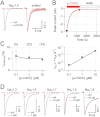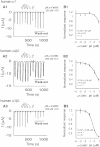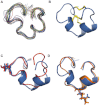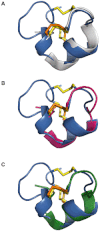A novel µ-conopeptide, CnIIIC, exerts potent and preferential inhibition of NaV1.2/1.4 channels and blocks neuronal nicotinic acetylcholine receptors
- PMID: 22229737
- PMCID: PMC3419909
- DOI: 10.1111/j.1476-5381.2012.01837.x
A novel µ-conopeptide, CnIIIC, exerts potent and preferential inhibition of NaV1.2/1.4 channels and blocks neuronal nicotinic acetylcholine receptors
Abstract
Background and purpose: The µ-conopeptide family is defined by its ability to block voltage-gated sodium channels (VGSCs), a property that can be used for the development of myorelaxants and analgesics. We characterized the pharmacology of a new µ-conopeptide (µ-CnIIIC) on a range of preparations and molecular targets to assess its potential as a myorelaxant.
Experimental approach: µ-CnIIIC was sequenced, synthesized and characterized by its direct block of elicited twitch tension in mouse skeletal muscle and action potentials in mouse sciatic and pike olfactory nerves. µ-CnIIIC was also studied on HEK-293 cells expressing various rodent VGSCs and also on voltage-gated potassium channels and nicotinic acetylcholine receptors (nAChRs) to assess cross-interactions. Nuclear magnetic resonance (NMR) experiments were carried out for structural data.
Key results: Synthetic µ-CnIIIC decreased twitch tension in mouse hemidiaphragms (IC(50) = 150 nM), and displayed a higher blocking effect in mouse extensor digitorum longus muscles (IC = 46 nM), compared with µ-SIIIA, µ-SmIIIA and µ-PIIIA. µ-CnIIIC blocked Na(V)1.4 (IC(50) = 1.3 nM) and Na(V)1.2 channels in a long-lasting manner. Cardiac Na(V)1.5 and DRG-specific Na(V)1.8 channels were not blocked at 1 µM. µ-CnIIIC also blocked the α3β2 nAChR subtype (IC(50) = 450 nM) and, to a lesser extent, on the α7 and α4β2 subtypes. Structure determination of µ-CnIIIC revealed some similarities to α-conotoxins acting on nAChRs.
Conclusion and implications: µ-CnIIIC potently blocked VGSCs in skeletal muscle and nerve, and hence is applicable to myorelaxation. Its atypical pharmacological profile suggests some common structural features between VGSCs and nAChR channels.
© 2012 The Authors. British Journal of Pharmacology © 2012 The British Pharmacological Society.
Figures







Similar articles
-
Mechanism and molecular basis for the sodium channel subtype specificity of µ-conopeptide CnIIIC.Br J Pharmacol. 2012 Oct;167(3):576-86. doi: 10.1111/j.1476-5381.2012.02004.x. Br J Pharmacol. 2012. PMID: 22537004 Free PMC article.
-
Atypical alpha-conotoxin LtIA from Conus litteratus targets a novel microsite of the alpha3beta2 nicotinic receptor.J Biol Chem. 2010 Apr 16;285(16):12355-66. doi: 10.1074/jbc.M109.079012. Epub 2010 Feb 9. J Biol Chem. 2010. PMID: 20145249 Free PMC article.
-
A novel conotoxin from Conus striatus, mu-SIIIA, selectively blocking rat tetrodotoxin-resistant sodium channels.Toxicon. 2006 Jan;47(1):122-32. doi: 10.1016/j.toxicon.2005.10.008. Epub 2005 Dec 1. Toxicon. 2006. PMID: 16325217
-
Structure and function of μ-conotoxins, peptide-based sodium channel blockers with analgesic activity.Future Med Chem. 2014 Oct;6(15):1677-98. doi: 10.4155/fmc.14.107. Future Med Chem. 2014. PMID: 25406007 Free PMC article. Review.
-
A review on conotoxins targeting ion channels and acetylcholine receptors of the vertebrate neuromuscular junction.Acta Physiol Pharmacol Ther Latinoam. 1999;49(4):257-67. Acta Physiol Pharmacol Ther Latinoam. 1999. PMID: 10797869 Review.
Cited by
-
Structural Diversity of Ultralong CDRH3s in Seven Bovine Antibody Heavy Chains.Front Immunol. 2019 Mar 22;10:558. doi: 10.3389/fimmu.2019.00558. eCollection 2019. Front Immunol. 2019. PMID: 30967877 Free PMC article.
-
Pathophysiological Responses to Conotoxin Modulation of Voltage-Gated Ion Currents.Mar Drugs. 2022 Apr 23;20(5):282. doi: 10.3390/md20050282. Mar Drugs. 2022. PMID: 35621933 Free PMC article. Review.
-
A novel proline-rich M-superfamily conotoxin that can simultaneously affect sodium, potassium and calcium currents.J Venom Anim Toxins Incl Trop Dis. 2021 Jun 11;27:e20200164. doi: 10.1590/1678-9199-JVATITD-2020-0164. eCollection 2021. J Venom Anim Toxins Incl Trop Dis. 2021. PMID: 34234819 Free PMC article.
-
Molecular phylogeny, classification and evolution of conopeptides.J Mol Evol. 2012 Jun;74(5-6):297-309. doi: 10.1007/s00239-012-9507-2. Epub 2012 Jul 4. J Mol Evol. 2012. PMID: 22760645
-
Distinct disulfide isomers of μ-conotoxins KIIIA and KIIIB block voltage-gated sodium channels.Biochemistry. 2012 Dec 11;51(49):9826-35. doi: 10.1021/bi301256s. Epub 2012 Nov 28. Biochemistry. 2012. PMID: 23167564 Free PMC article.
References
-
- Bax A, Davis DG. MLEV-17 based two-dimensional homonuclear magnetization transfer spectroscopy. J Magn Reson. 1985;65:355–360.
-
- Brünger AT, Adams PD, Clore GM, DeLano WL, Gros P, Grosse-Kunstleve RW, et al. Crystallography & NMR system: a new software suite for macromolecular structure determination. Acta Crystallogr D Biol Crystallogr. 1998;54:905–921. - PubMed
-
- Bulaj G, West PJ, Garrett JE, Watkins M, Zhang MM, Norton RS, et al. Novel conotoxins from Conus striatus and Conus kinoshitai selectively block TTX-resistant sodium channels. Biochemistry. 2005;44:7259–7265. - PubMed
Publication types
MeSH terms
Substances
LinkOut - more resources
Full Text Sources
Other Literature Sources
Miscellaneous

